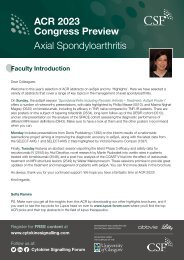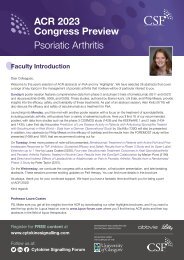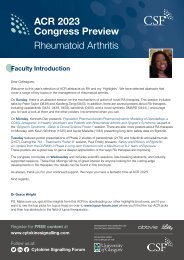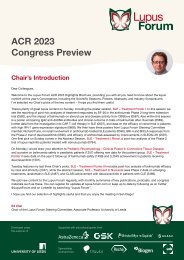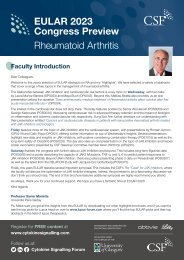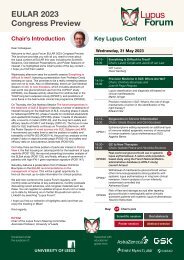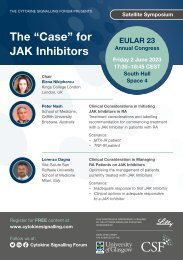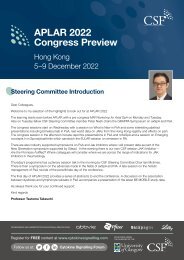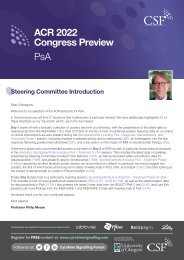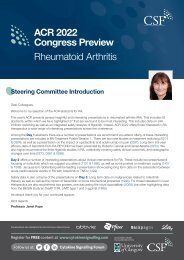EULAR 2018 Review
Create successful ePaper yourself
Turn your PDF publications into a flip-book with our unique Google optimized e-Paper software.
1 case was multidermatomal. Among the patients who were not vaccinated, 15 had HZ,<br />
there were 2 serious HZ events, 2 multidermatomal events and 1 disseminated event<br />
[#0220].<br />
Identification of heterogeneous phenotypic subgroups of patients with RA<br />
Bykerk and colleagues reported that it is possible to identify heterogeneous phenotypic<br />
subgroups with distinct disease activity in patients with RA who are csDMARD-IR and<br />
treated with tofacitinib. Models were based on pooled data from Phase 3 studies of<br />
tofacitinib 5 mg BID. The groups were characterised by differences in disease activity and<br />
patient-relevant outcomes, including baseline pain and physical function. The authors<br />
proposed that the identification of distinct disease trajectories could be used to develop<br />
personalised treatment algorithms incorporating clinical and molecular phenotypes<br />
[#0217].<br />
Poster Tour: Breakout news on non-TNF biologics in RA<br />
Real world evidence: bDMARD treatment persistence and reasons for discontinuation<br />
A poster on reasons for bDMARD cessation and subsequent persistence of second-line<br />
treatment in a large real world rheumatoid arthritis registry was presented by Youssef, et<br />
al. The analysis included patients aged ≥18 years with confirmed RA who were treated<br />
with first line b/tsDMARDs (1 st August 2010 to 30 th June 2017) by physicians participating<br />
in the OPAL-QUMI database. A total of 6914 patients received first line b/tsDMARDs.<br />
Treatment was stopped in 38% of patients; 34% stopped within 6 months of initiation, with<br />
the highest and lowest percentage observed in patients receiving tofacitinib (54%) and<br />
tocilizumab (17%), respectively. The most common reasons for stopping therapy within 6<br />
months were lack of efficacy (45%>abatacept, 44%>TNFis, 33%>tofacitinib and<br />
27%>tocilizumab) and adverse reactions (21%> tofacitinib, 20%> tocilizumab,<br />
15%>TNFis, 13%>abatacept). The percentage of patients remaining on 2nd line<br />
b/tsDMARD treatment after stopping first line TNFis due to lack of efficacy was the highest<br />
at 6 months with tocilizumab (78%) and at 12 months with rituximab (75%) [#0165].<br />
Poster Tour: The hydra beast in RA: a multifaceted disease<br />
Tofacitinib development programme: liver enzyme abnormalities<br />
Soriano, et al. reported a prevalence of hepatic steatosis of 1.6% in 10,212 patients across<br />
the tofacitinib RA, PsA and PsO programmes (1.3% in RA, 3.8% in PsA and 1.6% in PsO).<br />
In both tofacitinib- and placebo-treated patients, the incidence of elevated total bilirubin,<br />
aspartate aminotransferase (AST) and alanine aminotransferase (ALT) >1x ULN up to<br />
Month 3 was higher in patients with hepatic steatosis than in those without, across<br />
indications. The incidence of elevated total bilirubin, AST and ALT >3x ULN up to Month 3<br />
was low across indications, irrespective of hepatic steatosis [#0099].



